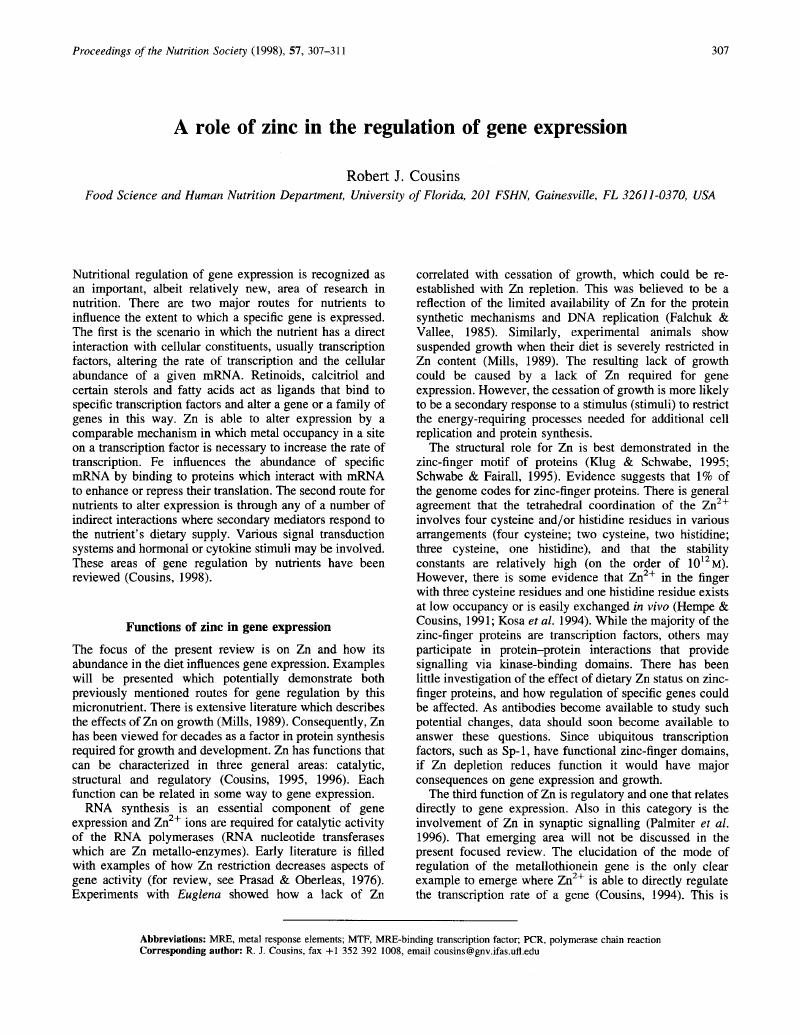Crossref Citations
This article has been cited by the following publications. This list is generated based on data provided by Crossref.
OLOVNIKOV, A.M.
1999.
The Telomere Shortening Signal May Be Explained by a Fountain Mechanism Modulating the Expression of Eukaryotic Genes.
Journal of Anti-Aging Medicine,
Vol. 2,
Issue. 1,
p.
59.
Hambidge, Michael
2000.
Human Zinc Deficiency.
The Journal of Nutrition,
Vol. 130,
Issue. 5,
p.
1344S.
Cao, Jiayin
and
Cousins, Robert J.
2000.
Metallothionein mRNA in Monocytes and Peripheral Blood Mononuclear Cells and in Cells from Dried Blood Spots Increases after Zinc Supplementation of Men.
The Journal of Nutrition,
Vol. 130,
Issue. 9,
p.
2180.
Mocchegiani, Eugenio
Muzzioli, Mario
and
Giacconi, Robertina
2000.
Zinc and immunoresistance to infection in aging: new biological tools.
Trends in Pharmacological Sciences,
Vol. 21,
Issue. 6,
p.
205.
Gabryelak, T
Filipiak, A
and
Brichon, G
2000.
Effects of zinc on lipids of erythrocytes from carp (Cyprinus carpio L.) acclimated to different temperatures.
Comparative Biochemistry and Physiology Part C: Pharmacology, Toxicology and Endocrinology,
Vol. 127,
Issue. 3,
p.
335.
Satre, Michael A.
Jessen, Katayoun Alavi
Clegg, Michael S.
and
Keen, Carl L.
2001.
Retinol binding protein expression is induced in HepG2 cells by zinc deficiency.
FEBS Letters,
Vol. 491,
Issue. 3,
p.
266.
Dreosti, Ivor E.
2001.
Zinc and the gene.
Mutation Research/Fundamental and Molecular Mechanisms of Mutagenesis,
Vol. 475,
Issue. 1-2,
p.
161.
Moore, J. Bernadette
Blanchard, Raymond K.
Cousins, Robert J.
and
McCormack, Wayne T.
2001.
cDNA Array Analysis Identifies Thymic LCK as Upregulated in Moderate Murine Zinc Deficiency before T-Lymphocyte Population Changes.
The Journal of Nutrition,
Vol. 131,
Issue. 12,
p.
3189.
Mocchegiani, Eugenio
Giacconi, Robertina
Cipriano, Catia
Muzzioli, Mario
Fattoretti, Patrizia
Bertoni-Freddari, Carlo
Isani, Gloria
Zambenedetti, Pamela
and
Zatta, Paolo
2001.
Zinc-bound metallothioneins as potential biological markers of ageing.
Brain Research Bulletin,
Vol. 55,
Issue. 2,
p.
147.
Krebs, Nancy F.
and
Hambidge, K. Michael
2001.
Zinc Biochemistry, Physiology, and Homeostasis.
p.
211.
Bonfante-Cabarcas, R.
Bravo, I.
Nello, C.
Gutiérrez-Reyes, E.
Loureiro Dos Santos, N. E.
and
Moreno-Yanes, J. A.
2002.
Pharmacological doses of Zn2+ induce a muscarinic cholinergic supersensitivity.
Journal of Biomedical Science,
Vol. 9,
Issue. 6,
p.
639.
Cousins, Robert J.
2002.
Trace Elements in Man and Animals 10.
p.
1.
Teresa, Gabryelak
Anna, Akahori
Maria, Przybylska
Zofia, Józwiak
and
Gerard, Brichon
2002.
Carp erythrocyte lipids as a potential target for the toxic action of zinc ions.
Toxicology Letters,
Vol. 132,
Issue. 1,
p.
57.
Mocchegiani, Eugenio
Giacconi, Robertina
Muzzioli, Mario
and
Cipriano, Catia
2002.
Basic Biology and Clinical Impact of Immunosenescence.
Vol. 13,
Issue. ,
p.
261.
Hambidge, Michael
and
Krebs, Nancy
2002.
Trace Elements in Man and Animals 10.
p.
977.
Fanzo, Jessica C.
Reaves, Scott K.
Cui, Libin
Zhu, Lei
and
Lei, Kai Y.
2002.
p53 protein and p21 mRNA levels and caspase-3 activity are altered by zinc status in aortic endothelial cells.
American Journal of Physiology-Cell Physiology,
Vol. 283,
Issue. 2,
p.
C631.
McMahon, Robert J.
2002.
BIOTIN INMETABOLISM ANDMOLECULARBIOLOGY.
Annual Review of Nutrition,
Vol. 22,
Issue. 1,
p.
221.
Krebs, Nancy F.
and
Westcott, Jamie
2002.
Integrating Population Outcomes, Biological Mechanisms and Research Methods in the Study of Human Milk and Lactation.
Vol. 503,
Issue. ,
p.
69.
Mocchegiani, Eugenio
Muzzioli, Mario
Giacconi, Robertina
Cipriano, Catia
Gasparini, Nazzarena
Franceschi, Claudio
Gaetti, Remo
Cavalieri, Elisabetta
and
Suzuki, Hisanori
2003.
Metallothioneins/PARP-1/IL-6 interplay on natural killer cell activity in elderly: parallelism with nonagenarians and old infected humans. Effect of zinc supply.
Mechanisms of Ageing and Development,
Vol. 124,
Issue. 4,
p.
459.
Chou, Chia-Cheng
Lin, Ting-Wan
Chen, Chin-Yu
and
Wang, Andrew H.-J.
2003.
Crystal Structure of the Hyperthermophilic Archaeal DNA-Binding Protein Sso10b2 at a Resolution of 1.85 Angstroms.
Journal of Bacteriology,
Vol. 185,
Issue. 14,
p.
4066.



